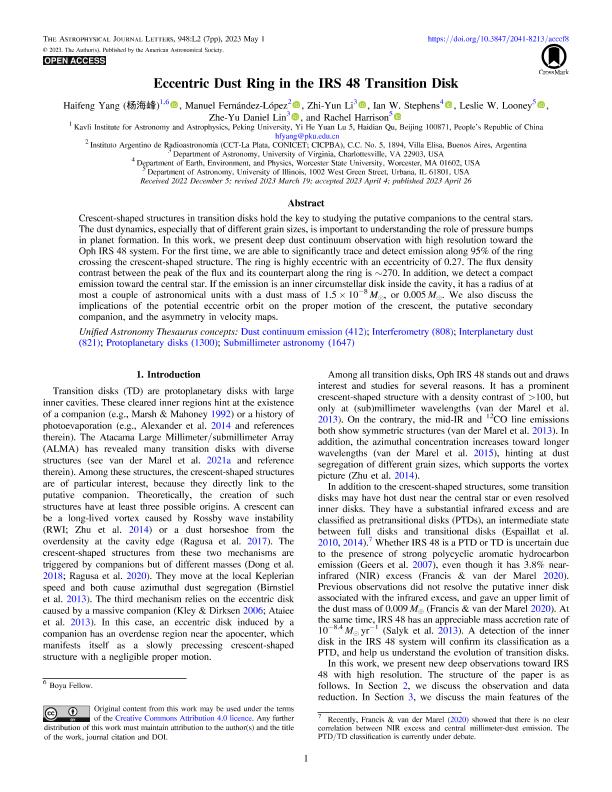Mostrar el registro sencillo del ítem
dc.contributor.author
Yang, Haifeng
dc.contributor.author
Fernandez Lopez, Manuel

dc.contributor.author
Li, Zhi Yun
dc.contributor.author
Stephens, Ian W.
dc.contributor.author
Looney, Leslie W.
dc.contributor.author
Lin, Zhe Yu Daniel
dc.contributor.author
Harrison, Rachel
dc.date.available
2023-11-14T16:22:46Z
dc.date.issued
2023-05
dc.identifier.citation
Yang, Haifeng; Fernandez Lopez, Manuel; Li, Zhi Yun; Stephens, Ian W.; Looney, Leslie W.; et al.; Eccentric Dust Ring in the IRS 48 Transition Disk; American Astronomical Society; Astrophysical Journal Letters; 948; 1; 5-2023; 1-7
dc.identifier.issn
2041-8205
dc.identifier.uri
http://hdl.handle.net/11336/218079
dc.description.abstract
Crescent-shaped structures in transition disks hold the key to studying the putative companions to the central stars. The dust dynamics, especially that of different grain sizes, is important to understanding the role of pressure bumps in planet formation. In this work, we present deep dust continuum observation with high resolution toward the Oph IRS 48 system. For the first time, we are able to significantly trace and detect emission along 95% of the ring crossing the crescent-shaped structure. The ring is highly eccentric with an eccentricity of 0.27. The flux density contrast between the peak of the flux and its counterpart along the ring is ∼270. In addition, we detect a compact emission toward the central star. If the emission is an inner circumstellar disk inside the cavity, it has a radius of at most a couple of astronomical units with a dust mass of 1.5 × 10−8 M ⊙, or 0.005 M ⊕. We also discuss the implications of the potential eccentric orbit on the proper motion of the crescent, the putative secondary companion, and the asymmetry in velocity maps.
dc.format
application/pdf
dc.language.iso
eng
dc.publisher
American Astronomical Society
dc.rights
info:eu-repo/semantics/openAccess
dc.rights.uri
https://creativecommons.org/licenses/by-nc-sa/2.5/ar/
dc.subject
Dust continuum emission
dc.subject
Interferometry
dc.subject
Interplanetary dust
dc.subject
Protoplanetary disks
dc.subject
Submillimeter astronomy
dc.subject.classification
Astronomía

dc.subject.classification
Ciencias Físicas

dc.subject.classification
CIENCIAS NATURALES Y EXACTAS

dc.title
Eccentric Dust Ring in the IRS 48 Transition Disk
dc.type
info:eu-repo/semantics/article
dc.type
info:ar-repo/semantics/artículo
dc.type
info:eu-repo/semantics/publishedVersion
dc.date.updated
2023-11-13T15:51:07Z
dc.identifier.eissn
2041-8213
dc.journal.volume
948
dc.journal.number
1
dc.journal.pagination
1-7
dc.journal.pais
Estados Unidos

dc.description.fil
Fil: Yang, Haifeng. Peking University; China
dc.description.fil
Fil: Fernandez Lopez, Manuel. Consejo Nacional de Investigaciones Científicas y Técnicas; Argentina. Provincia de Buenos Aires. Gobernación. Comisión de Investigaciones Científicas. Instituto Argentino de Radioastronomía. Consejo Nacional de Investigaciones Científicas y Técnicas. Centro Científico Tecnológico Conicet - La Plata. Instituto Argentino de Radioastronomía; Argentina
dc.description.fil
Fil: Li, Zhi Yun. University of Virginia; Estados Unidos
dc.description.fil
Fil: Stephens, Ian W.. Worcester State University; Estados Unidos
dc.description.fil
Fil: Looney, Leslie W.. University of Illinois. Urbana - Champaign; Estados Unidos
dc.description.fil
Fil: Lin, Zhe Yu Daniel. University of Virginia; Estados Unidos
dc.description.fil
Fil: Harrison, Rachel. University of Illinois. Urbana - Champaign; Estados Unidos
dc.journal.title
Astrophysical Journal Letters
dc.relation.alternativeid
info:eu-repo/semantics/altIdentifier/doi/http://dx.doi.org/10.3847/2041-8213/acccf8
dc.relation.alternativeid
info:eu-repo/semantics/altIdentifier/url/https://iopscience.iop.org/article/10.3847/2041-8213/acccf8
Archivos asociados
